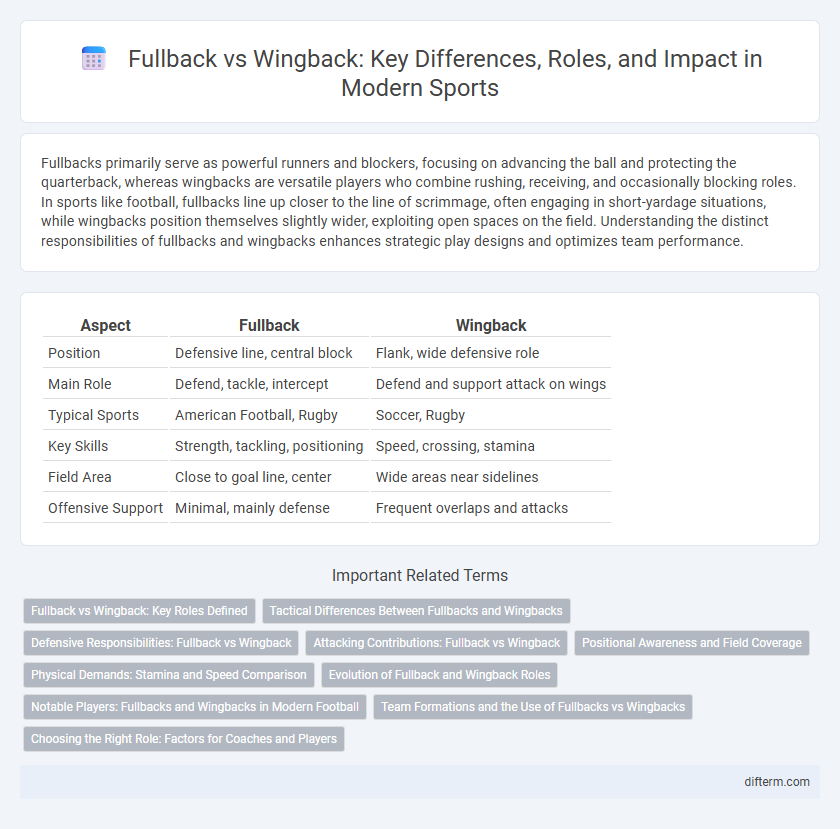Fullbacks primarily serve as powerful runners and blockers, focusing on advancing the ball and protecting the quarterback, whereas wingbacks are versatile players who combine rushing, receiving, and occasionally blocking roles. In sports like football, fullbacks line up closer to the line of scrimmage, often engaging in short-yardage situations, while wingbacks position themselves slightly wider, exploiting open spaces on the field. Understanding the distinct responsibilities of fullbacks and wingbacks enhances strategic play designs and optimizes team performance.
Table of Comparison
| Aspect | Fullback | Wingback |
|---|---|---|
| Position | Defensive line, central block | Flank, wide defensive role |
| Main Role | Defend, tackle, intercept | Defend and support attack on wings |
| Typical Sports | American Football, Rugby | Soccer, Rugby |
| Key Skills | Strength, tackling, positioning | Speed, crossing, stamina |
| Field Area | Close to goal line, center | Wide areas near sidelines |
| Offensive Support | Minimal, mainly defense | Frequent overlaps and attacks |
Fullback vs Wingback: Key Roles Defined
Fullbacks primarily serve as defensive stalwarts positioned centrally to thwart opposing attackers and initiate offensive plays with precise passes. Wingbacks operate along the flanks, balancing strong defensive responsibilities with aggressive support in wide attacking zones to deliver crosses and stretch the opposition. Understanding the distinct tactical functions of fullbacks and wingbacks is essential for optimizing team formation and gameplay dynamics.
Tactical Differences Between Fullbacks and Wingbacks
Fullbacks primarily play a defensive role, focusing on marking opponents and maintaining the team's defensive structure, while wingbacks blend defensive duties with offensive support by advancing along the flanks to provide width and crossing opportunities. Wingbacks require higher stamina and speed due to their dual responsibilities in attacking and defending, often operating in formations with three central defenders that allow more freedom to push forward. Tactical differences between fullbacks and wingbacks manifest in positioning, with fullbacks staying deeper to protect the back line and wingbacks exploiting space higher up the pitch to create overloads and facilitate quick transitions.
Defensive Responsibilities: Fullback vs Wingback
Fullbacks primarily focus on solid defensive positioning, marking opposing wingers, and intercepting plays to prevent crosses and goals. Wingbacks balance defensive duties with offensive support, tracking back quickly to cover wide areas and engage in one-on-one defensive battles. Their defensive responsibilities are critical in maintaining team shape and preventing opposition breakthroughs on the flanks.
Attacking Contributions: Fullback vs Wingback
Wingbacks typically offer more dynamic attacking contributions than fullbacks, frequently advancing higher up the pitch to provide crosses, key passes, and overlapping runs. Fullbacks often prioritize defensive duties but still support attacks by maintaining width and delivering accurate crosses from deeper positions. The wingback's dual role as a defender and winger makes them integral to creating scoring opportunities in formations like 3-5-2 or 5-3-2.
Positional Awareness and Field Coverage
Fullbacks excel in positional awareness by maintaining a solid defensive line while offering overlapping runs to support midfielders, balancing attack and defense. Wingbacks provide extensive field coverage by operating along the flanks, combining the responsibilities of wingers and fullbacks to exploit wide spaces and deliver crosses. Both roles require acute spatial intelligence, but wingbacks demand greater stamina and versatility to cover the entire sideline effectively.
Physical Demands: Stamina and Speed Comparison
Fullbacks require exceptional stamina to maintain continuous defensive coverage and initiate counterattacks, while wings backs demand superior speed to exploit wide spaces and support offensive plays swiftly. The fullback's physical endurance emphasizes sustained high-intensity efforts over 90 minutes, contrasting with the wingback's need for rapid acceleration and agility to navigate flanks effectively. Both positions challenge players physically but prioritize different aspects of stamina and speed based on tactical roles in modern football.
Evolution of Fullback and Wingback Roles
The evolution of fullback and wingback roles in sports, particularly in soccer and American football, reflects strategic shifts emphasizing versatility and offensive contributions. Fullbacks transitioned from purely defensive positions to dynamic players supporting attacks and overlapping with wingers, while wingbacks emerged to blend defensive duties with wide midfield responsibilities, enhancing width and crossing abilities. Modern formations frequently deploy wingbacks in a hybrid role, capitalizing on their stamina and technical skills to dominate flanks and create scoring opportunities.
Notable Players: Fullbacks and Wingbacks in Modern Football
Notable modern football fullbacks like Trent Alexander-Arnold and Dani Alves excel in both defensive duties and creative attacking support, often contributing assists and key passes. Wingbacks such as Marcelo and Jordi Alba are renowned for their relentless pace and ability to provide width, combining high stamina with offensive prowess to join attacks frequently. These players redefine their roles by balancing defensive solidity with dynamic forward runs, highlighting the evolution of fullbacks and wingbacks in contemporary football tactics.
Team Formations and the Use of Fullbacks vs Wingbacks
In football team formations, fullbacks primarily serve defensive roles in a traditional back four, offering width and protection along the flanks, while wingbacks operate in formations with three central defenders, such as 3-5-2 or 3-4-3, balancing defensive duties with aggressive attacking support. Wingbacks require exceptional stamina and versatility to transition rapidly between defense and attack, often contributing to creating scoring opportunities through crosses and overlaps. Coaches select fullbacks for solidity and defensive reliability in balanced formations, whereas wingbacks are favored in dynamic, attacking systems demanding width and fluidity on the flanks.
Choosing the Right Role: Factors for Coaches and Players
Fullbacks excel in defensive stability and aerial duels, making them ideal for teams prioritizing solid backline protection, while wingbacks thrive on overlapping runs and crossing abilities, suiting attacking formations needing width and pace. Coaches must evaluate player stamina, speed, and crossing accuracy to determine the best fit between a traditional fullback or a more dynamic wingback role. Tactical setup, opponent strategy, and individual skill sets remain crucial factors influencing the selection of either defensive position in modern football.
fullback vs wingback Infographic

 difterm.com
difterm.com